The ASUS Zenbook UX305 Review
by Brett Howse on March 25, 2015 8:00 AM ESTGPU Performance
On the GPU side, the Core M-5Y10 has the Intel HD 5300 Gen8 graphics of Broadwell, but with clock speeds of 100 Mhz to 800 Mhz, as compared to the 5Y71 which has 300MHz to 900 MHz available. We have tested several Broadwell processors so far, and the Gen8 graphics are a reasonable boost over the Haswell Gen 7.5 model, with a bump in execution units (EU) from 20 on Haswell to 24 on Broadwell. The Yoga 3 Pro has the Core M 5Y71, which on paper should offer more performance than the 5Y10 based UX305 that we received for review.
One thing that became clear on the Yoga 3 Pro review was how even though the GPU was the same number of EUs as the Broadwell-U processors, and it has the same base and boost clock speed, the 4.5 watt window of Core M limited performance quite a bit. As we saw on the system performance already though, ASUS has elected to allow Core M to get hotter, so that may change the outcome on the GPU as well.
FutureMark 3DMark

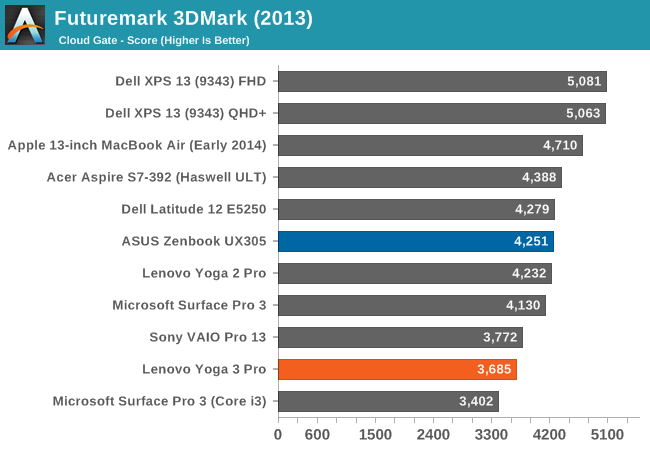
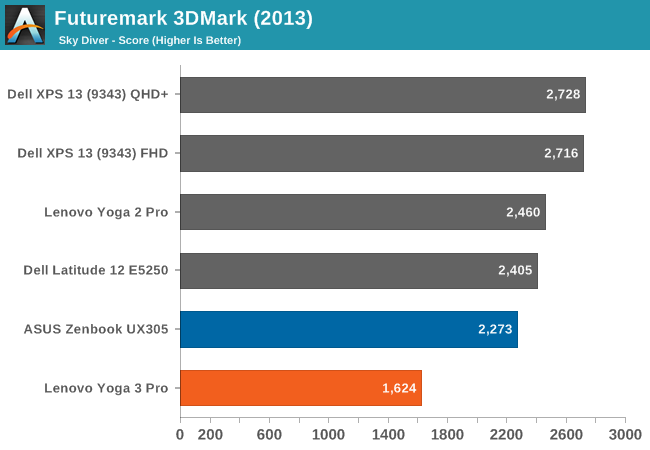

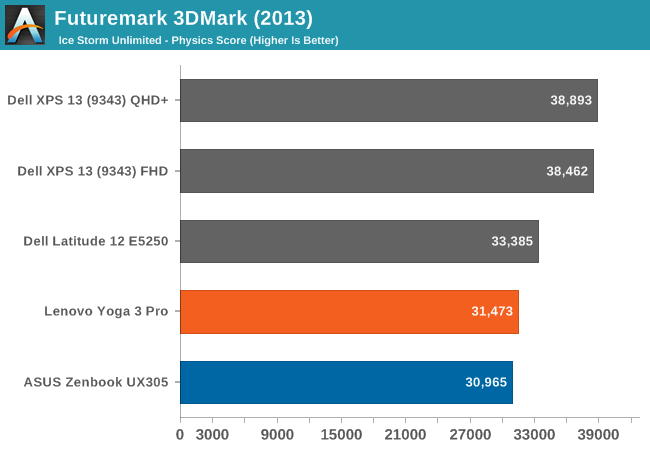
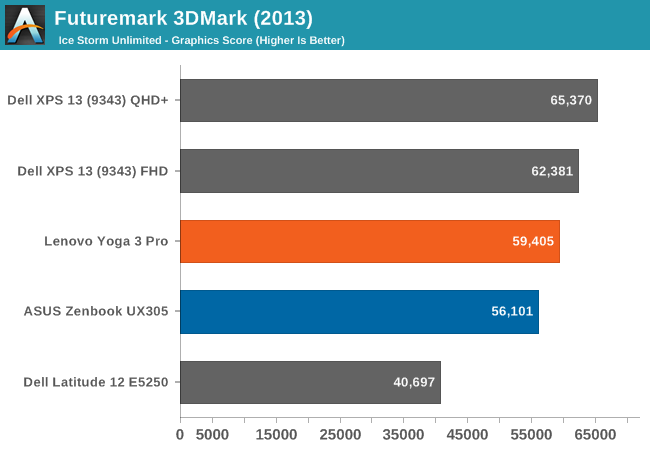
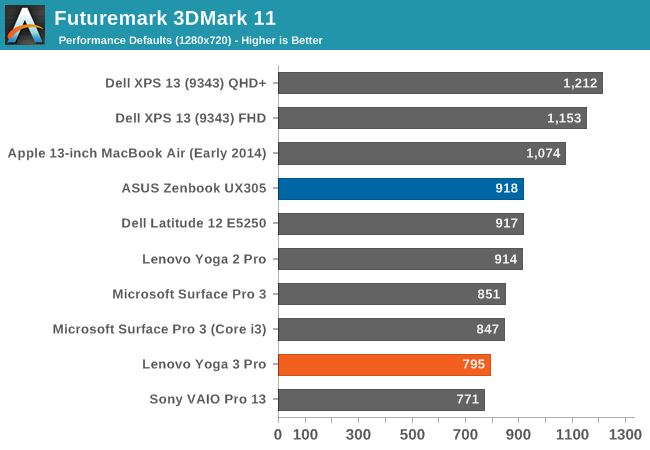
FutureMark has compiled several benchmarks in 3DMark 2013. All are a reasonable length, except for Ice Storm Unlimited which is more of a smartphone/tablet benchmark, and therefore completes very quickly on a PC. Here we can see how much more performance the ASUS UX305 can deliver over the Yoga 3 Pro, which again on paper has a faster processor. ASUS allows much more thermal headroom on the SoC, which results in considerably better scores when using the GPU. The exception to this is the Ice Storm Unlimited, which completes quick enough that the Yoga 3 Pro does not have to throttle as much.
GFXBench
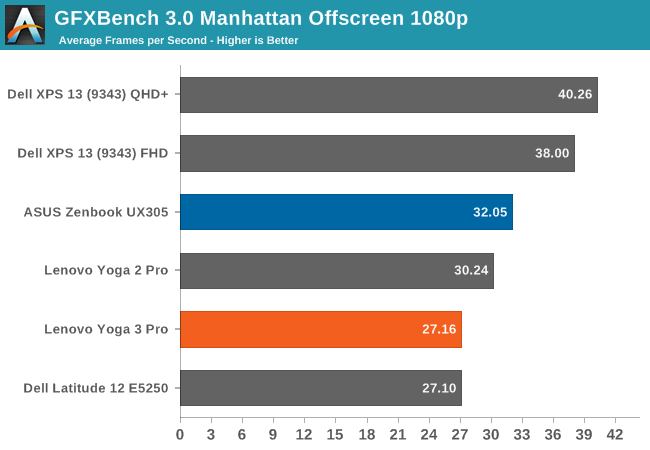
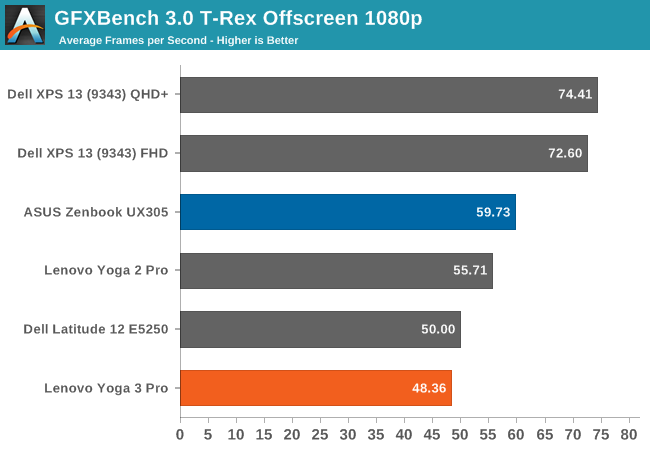
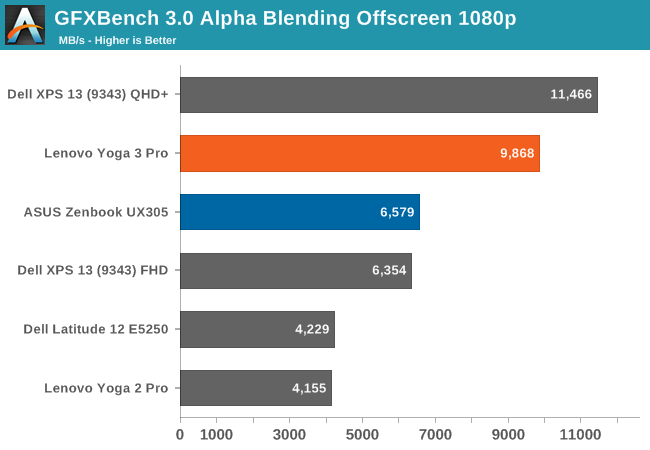
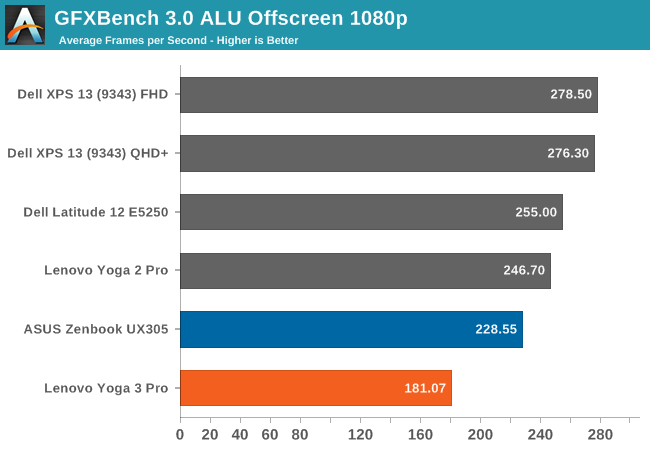
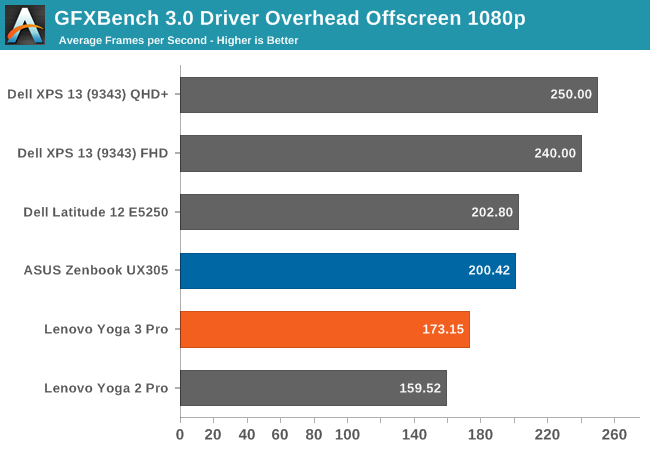
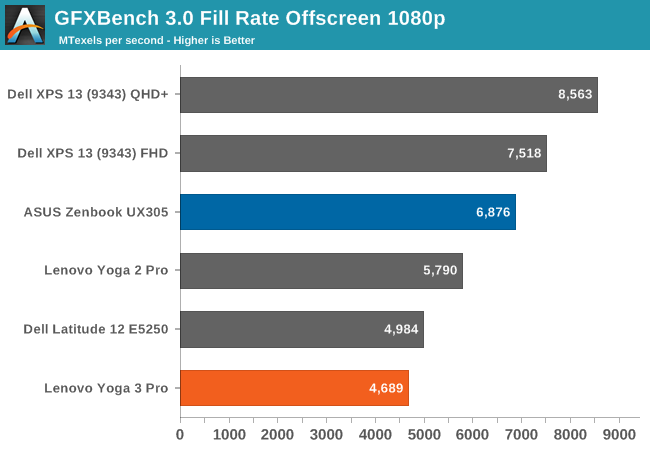
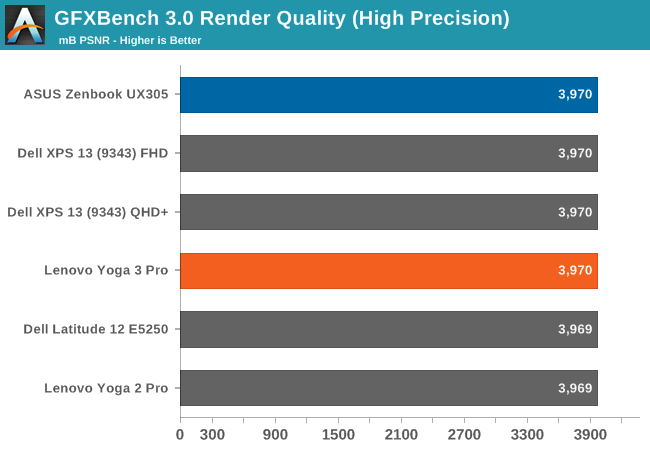
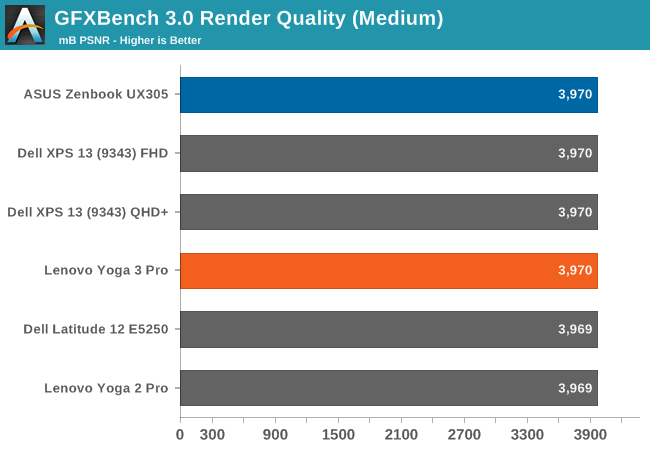
GFXBench 3.0 is available in the Windows Store, and is a DirectX version of GFXBench. On the two gaming benchmarks (Manhattan and T-Rex) we can see that the UX305 pulls ahead of both of the Haswell-U based devices in our graphs, which are the Yoga 2 Pro and the Latitude 12. The Dell XPS 13, with Broadwell-U, is still a lot more powerful which is not surprising since it has a 15 watt TDP compared to just 4.5 watts on Core M (Broadwell-Y). Once again, we can see that the ASUS is stronger than the Yoga 3 Pro.
DOTA 2 Benchmarks
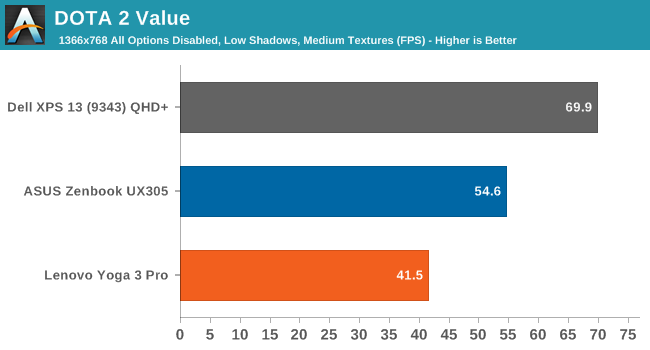
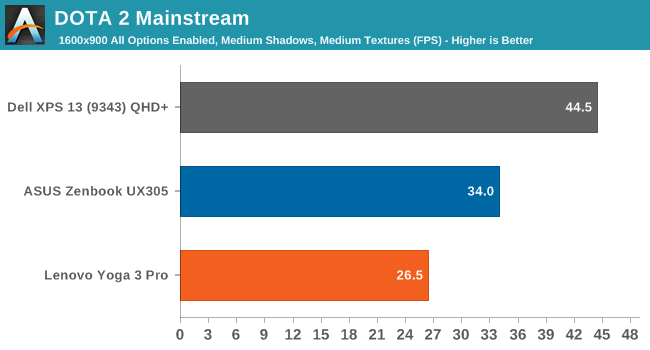
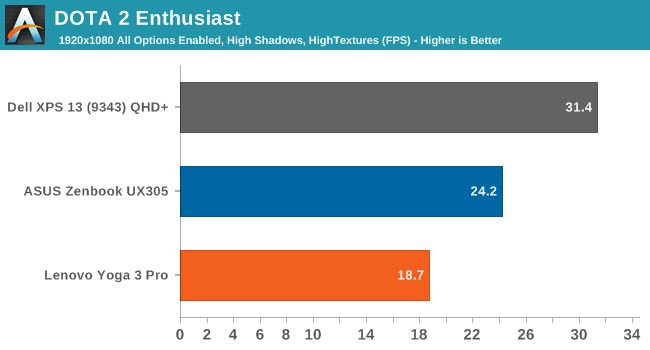
One area where the Yoga 3 Pro struggled was with our DOTA 2 benchmark, which is quite long in duration. We run at three different levels, and the Yoga 3 Pro fell quite far behind the Dell XPS 13. The ASUS UX305 closes that gap though, and gave a much higher frames per second than the Yoga 3 Pro.
Tablet Comparison
As with the Yoga 3 Pro, we will compare the ASUS UX305 to several tablets to see where Core M fits in the lineup. The UX305 is certainly not a tablet competitor unlike the Yoga 3 Pro, but the improved GPU performance seen in the laptop comparisons should give us some more information to about where the Intel graphics compare to the best SoC GPUs available today.
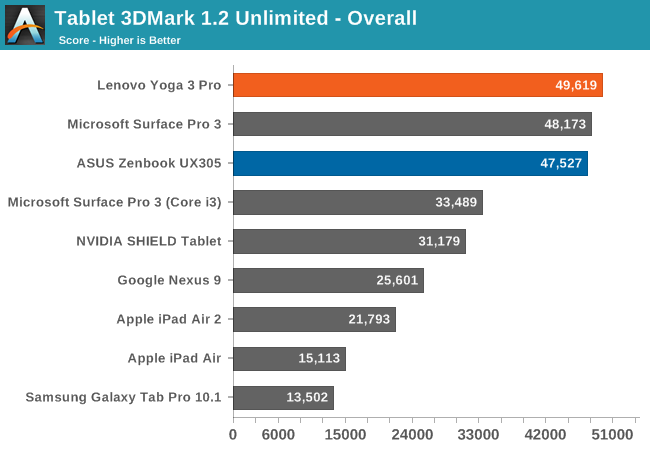
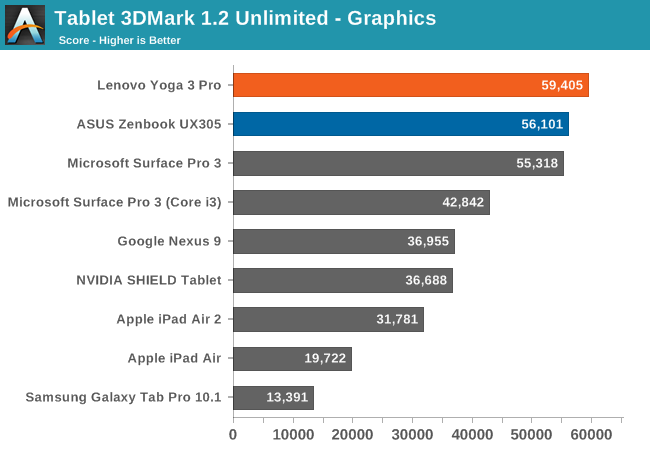

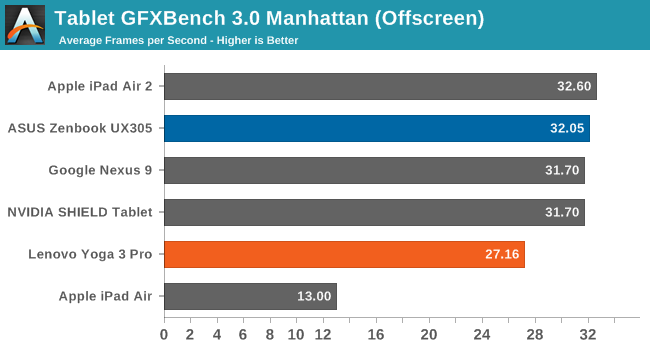
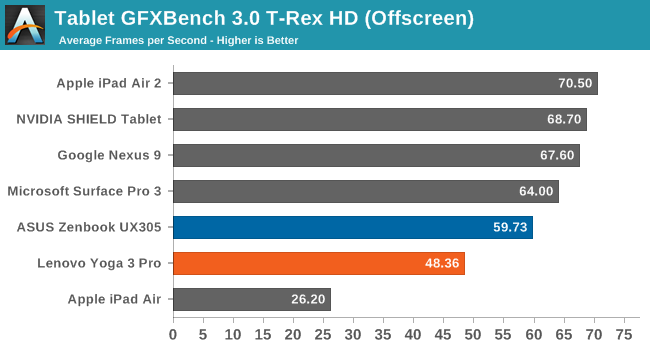


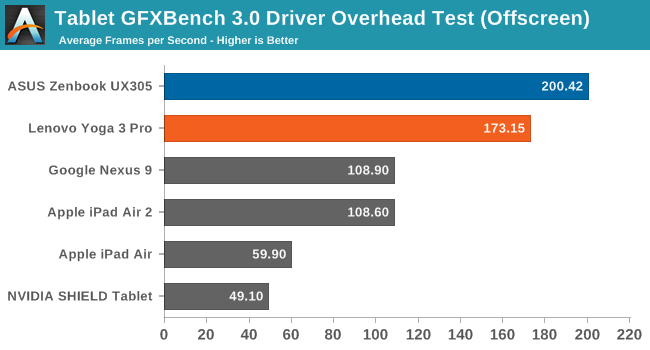
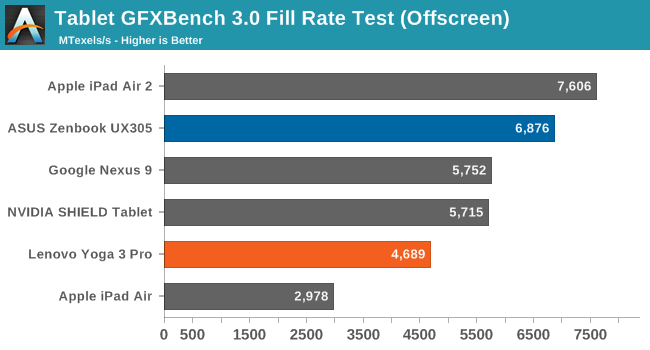
3DMark Unlimited shows the capabilities of the GPU, but is so short that the throttling issues we have observed do not come in to play. The Gen8 graphics of HD 5300 should certainly be able to compete favorably to any of the tablet SoCs if give enough headroom, however that is obviously not the case.
The GFXBench scores show that the Core M 5Y10 can compete with tablets, with it coming in very close to the same scores as all of the latest tablets on the Manhattan score. The T-Rex benchmark is much easier, and it falls behind a bit, but is still a lot quicker than the Yoga 3 Pro.
GPU Conclusion
The increased thermal headroom that ASUS allows on the UX305 has dramatically increased the GPU performance of Core M when compared to the Yoga 3 Pro. The device does get warm though, with it hitting close to 50°C at the top of the laptop, but it does not affect the keyboard or wrist areas. The lack of a fan makes these scores even more surprising, but Lenovo has opted to keep the surface temperatures a lot lower on the Yoga 3 Pro.
There is a lot to be said about Core M performance, and too much to put in this review. We will be doing a deeper dive into the performance of Core M and how it performs in various devices, both actively and passively cooled, as well as compared to Broadwell-U based systems which are a more traditional design. Clearly, there is a lot of factors that affect performance in a device such as this than just the label on the spec sheet.


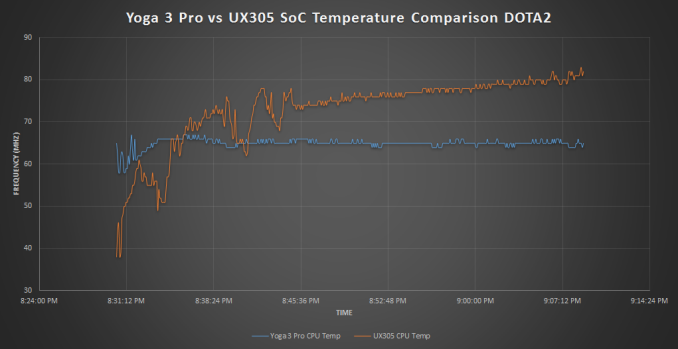








164 Comments
View All Comments
thesavvymage - Wednesday, March 25, 2015 - link
im just an intern, but for my use case and everyone who works with me, this machine is NOT adequate for professional excel use. itd fall on its face trying to do pivots/charts with any substantial amount of rowsFlushedBubblyJock - Wednesday, March 25, 2015 - link
Watch, all these "premium feel", self centered, glory money show off, "elite items" freaks who want more than anything to feel rich inside when using their computer prods, will all have early onset alzheimer's, from picking and licking with their "super premium expensive feel" bragging egotist aluminum puters.I can hardly wait, though in that soon to engulf future condition they probably won't be able to understand why it happened to them.... just keeping rubbing those super elite aluminum bodies you constantly pine for...
kyuu - Wednesday, March 25, 2015 - link
While I actually prefer the design of, for example, the Yoga over aluminum designs like this or MacBooks, your spiel is rather psychopathic.FlushedBubblyJock - Wednesday, March 25, 2015 - link
Thanks for reading the vent, though don't say you weren't warned. Hands all over brushed aluminum all day long is the recipe for alzheimer's.Dorek - Thursday, March 26, 2015 - link
Uh, that's not proven at all. There are at least as many studies questioning environmental factors as there are attesting that they are a major cause of Alzheimer's.djvita - Wednesday, March 25, 2015 - link
A small correction 10dB means its ten times louder. Wikipedia on decibel- "A change in power by a factor of 10 corresponds to a 10 dB change in level. A change in power by a factor of two approximately corresponds to a 3 dB change. "back on the review, if my laptop were to die, this would be the laptop to get. I have an Asus b43j, with 6GB ram (bought 4) and saving for an mx200 ssd (has a 5400rpm 320gb drive). bought it 4 years ago. still good as new. the aluminum is nice. I expect that the quality is still the same in Asus products.
Brett Howse - Wednesday, March 25, 2015 - link
10 dB is ten times the power of the sound wave, but roughly twice the perceived loudness.Conficio - Wednesday, March 25, 2015 - link
"The speakers are downward firing through two grilles on the bottom of the device." Would that be an explanation for the raising hinge design? Lifting the bottom of the laptop to give the soung waves a bit more room to escape?Brett Howse - Wednesday, March 25, 2015 - link
Unfortunately no the speakers are at the front of the device.Mobile-Dom - Wednesday, March 25, 2015 - link
do we know the SSD type on here? i havent seen it be noted anywere? is it MSATA? M.2 SATA, M.2 PCIe? i just have no clue